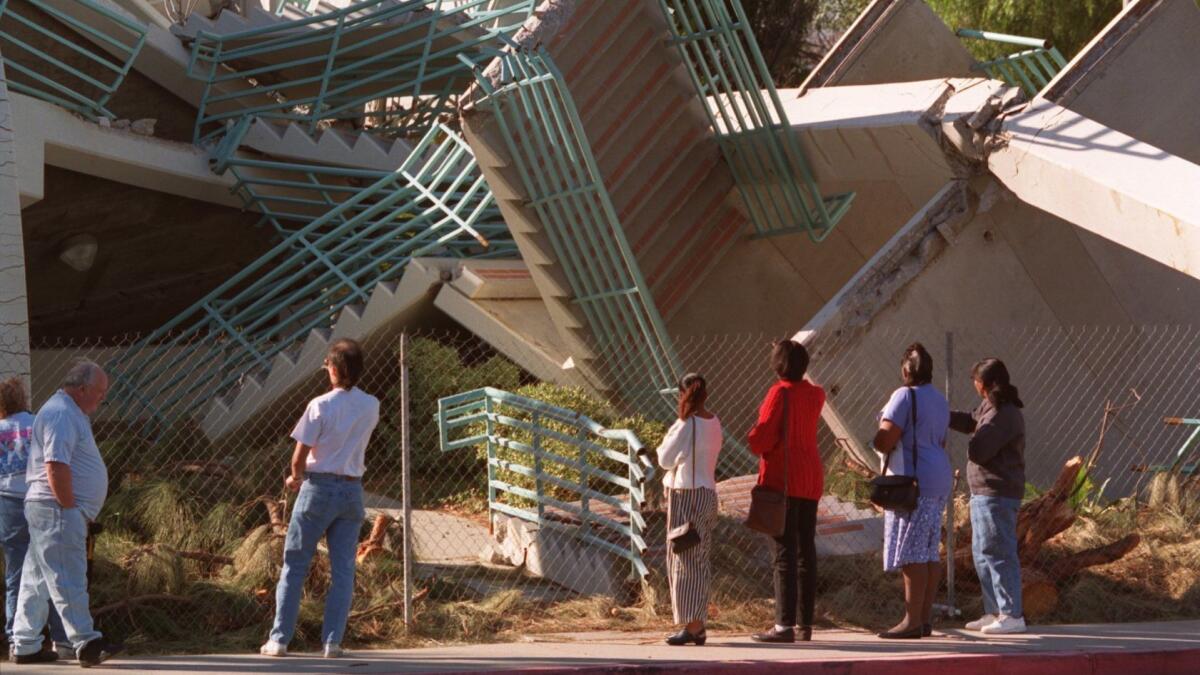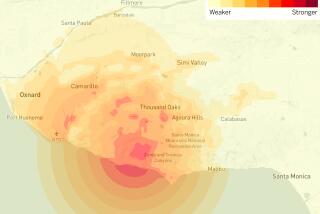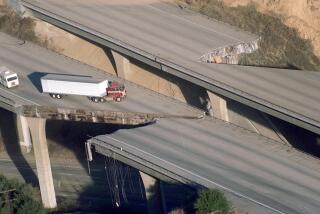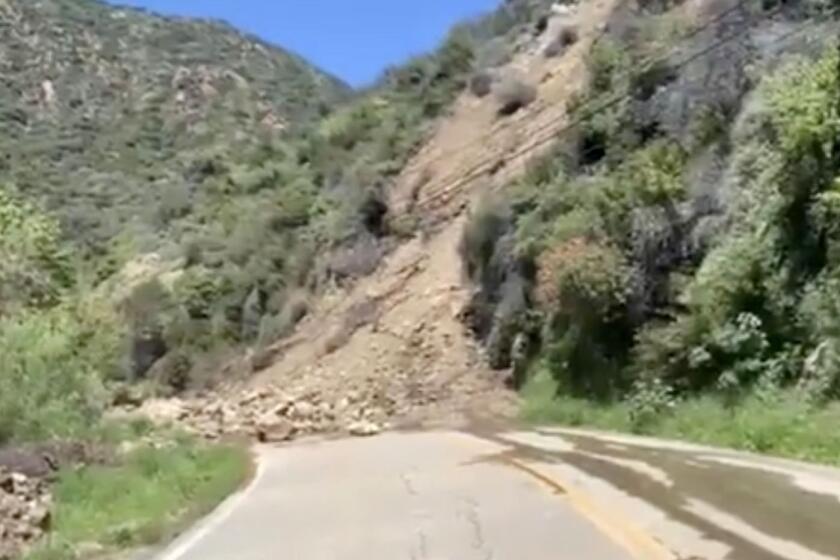A quake every 3 minutes: California shaken by 10 times more temblors than previously known

California has experienced 10 times more earthquakes than previously known, according to groundbreaking new research that has helped scientists better understand the region’s seismology.
Scientists documented 1.8 million earthquakes in Southern California over the last decade — with 90% of them newly discovered and so small they had long been undetectable to modern computing systems. Previously, only 180,000 earthquakes were on record for the last 10 years.
Researchers now have a better ability to identify undiscovered faults, detect patterns of moving earthquake swarms, and identify faint clusters of foreshocks that occur before a larger earthquake.
“We see incredible details,” Caltech seismologist Zachary Ross said of the newly discovered earthquakes he outlined in a study released Thursday in the journal Science, of which he was the lead author. “We start to see new faults emerging.”
“It is a pretty exciting moment in seismology,” said Kate Scharer, a U.S. Geological Survey research geologist who was not involved in the study. “It’s long been desired to understand ... what’s happening in the time leading up to large earthquakes. A big question for us is how the state of stress might evolve, anywhere from days to months, leading up to large earthquakes.”
Scientists have long understood a key mathematical relationship in earthquake magnitudes: For each whole-number drop in magnitude, there are 10 times as many earthquakes. For instance, for every magnitude 7 earthquake, there are 10 magnitude 6 temblors, 100 magnitude 5 shakers, 1,000 magnitude 4 events, and so forth.
But until now, scientists hadn’t been able to collect a comprehensive inventory of earthquakes of less than magnitude 1.7 (with some recorded as small as magnitude negative 2) over a wide region and a period of years.
The discovery of these micro-earthquakes in Southern California is the first time magnitude 0 and magnitude 1 earthquakes have been documented over such a vast region during a long period — between 2008 and 2017.
This means a detectable earthquake, on average, occurs every 3 minutes in Southern California — much more frequent than the old estimate of one temblor every half-hour.
An eye-popping result from the discovery was showing just how widespread an effect the last big earthquake had after it shook Southern California — the Easter Sunday magnitude 7.2 earthquake of 2010. That event had an epicenter across the border, close to the Mexican city of Mexicali.
Previously, it was clear only that the Easter Sunday earthquake triggered an increased rate of temblors — within a week of the main quake — up to about 100 miles away from its epicenter, reaching rural eastern San Diego County and the Salton Sea area.
Now, there’s evidence it actually increased earthquake activity as much as 170 miles away — reaching Riverside, San Bernardino and Palm Springs.
“You can really see the extent, now, to which this one big earthquake is able to affect this huge region that we just couldn’t see before,” Ross said. “It shows in a lot of ways that these fault systems are related to each other. … The more that we dig deeper, the more it seems there’s some connection there.”
The data could also help scientists demystify the start to sequences of earthquakes.
“Why do they start the way they do? Is it really just one mainshock that hits, or is there more stuff leading up to it?” Ross said. “Potentially, this could provide more information about how earthquake sequences start.”
There are other exciting advances made possible by this study. Among them:
- The scientists discovered a previously undetected series of foreshocks leading up to a swarm of earthquakes in the Imperial County town of Brawley in 2012, which caused shaking sharp enough to postpone the first day of school and shift 20 mobile homes from their foundations.
- It showed how a swarm of earthquakes moved geographically. An animation of an earthquake swarm around the town of Cahuilla, Calif., that started in 2016 and is still ongoing shows how seismic activity gradually moved westward and became shallower, Ross said, probably triggered by the movement of groundwater.
- The high-definition imaging of microquakes also presents the possibility of identifying new faults and understanding their shapes better; in some cases, instead of being flat, they’re found to be curving, which could alter our understanding about how earthquakes move.
Being able to find foreshocks that precede larger quakes is particularly thrilling for scientists. Half of all large quakes are preceded by smaller foreshocks.
“There may be some tiny earthquakes that occur before bigger ones that we haven’t seen in the past because we didn’t have the resolution,” said Caltech seismologist Egill Hauksson, a coauthor of the study.
Also, better understanding the map of earthquake faults under the surface will help scientists make better guesses for how the ground could shake at the surface, Scharer said.
To be sure, scientists still believe that it’s probably impossible to predict the exact time and location of future big earthquakes, and this study doesn’t change that.
The scientific advance shows the possibility, someday, of getting a higher-definition picture of microquakes in California in real time. That could help scientists understand when seismic activity becomes abnormally high in sensitive areas of the state close to California’s most dangerous faults.
“Small events provide us with the glue that connects the big events, so we have a more complete picture of the process of earthquake fault rupture,” Hauksson said.
Accomplishing the feat documented in Thursday’s study was a gargantuan task. Ross sifted through 10 years’ worth of seismic data, which run all day every day, from 500 stations throughout Southern California to identify the micro-earthquakes.
To do that, Ross had to overcome something that had long been a challenge: how to distinguish true, small earthquakes from background noise in the ground caused by, say, a truck rumbling over a pothole.
The solution was helped by a known feature of quakes of magnitude 4 or lower. Earthquakes that occur in a given geographic region vibrate in a certain way, providing a pattern as unique as a fingerprint because the shaking weaves through a specific path of rocks. This shaking pattern is captured in the squiggles recorded by machines that detect shaking during an earthquake.
Earthquakes that come from the same place — whether it’s a magnitude 3 earthquake or a magnitude 1 event — share a common signature. Of course, the magnitude 1 earthquake’s signature is far smaller than a magnitude 3’s, but zoom way in, and the signatures are virtually identical.
So Ross embarked on what amounted to a three-year effort: taking the Southern California inventory from 2000 to 2017 of seismic events up to magnitude 4 to create a dictionary, or a Rosetta stone, so to speak, that defined what specific squiggles in the seismic data were actually earthquakes.
Then he scaled those earthquake signatures to be smaller, and compared them to seismic data for tiny earthquakes — from magnitude negative 2 to magnitude 1.7. Soon enough, he was able to find matches — and finally, was able to distinguish and identify authentic microquakes and discard the background noise.
This technique has been used before in the last 15 years, but usually just to find microquake aftershocks over a two-week period, in a limited area, after significant earthquakes. Finding microquakes for a broader region over many years had been too difficult, given the processing of gargantuan amounts of data.
The achievement unlocked in this study was writing new computer code to squeeze a day’s worth of seismic data into one graphics processing unit for all of Southern California, have it come out relatively quickly and then repeat it, Hauksson said. Previously, researchers had generally used regular computers that were easier to use but far slower.
Ross wrote the computer code from scratch, and at one point got assistance from Santa Clara, Calif.-based Nvidia, a maker of graphics processing units, to optimize the code to run on its units. Also assisting were coauthors Daniel Trugman of Los Alamos National Laboratory and Peter Shearer of the Scripps Institution of Oceanography at UC San Diego.
The final data analysis — totaling 70 terabytes of data — eventually ran on 200 state-of-the-art graphics processing units in a new supercomputer at Caltech in Pasadena, which took a couple of weeks.
In the future, there’s potential to use artificial intelligence to help computers identify microquakes in real time, without the need to constantly compare new seismic events with a historical database.
“The next step is to train neural networks, which can be done, and we’ve done some of that already. Then we would deploy that in real time,” Hauksson said, similar to how artificial intelligence is used by computer software to identify faces in photographs.
There’s a key limitation to this study — it only shows micro-earthquakes in places where there have been more substantial quakes.
“If you look at the San Andreas, the San Andreas has been unbelievably quiet. It does not produce micro-seismicity like this in almost all the locations in Southern California,” Ross said.
Get ready for a major quake. What to do before — and during — a big one »
California’s in an exceptional earthquake drought. When will it end? »
More to Read
Start your day right
Sign up for Essential California for news, features and recommendations from the L.A. Times and beyond in your inbox six days a week.
You may occasionally receive promotional content from the Los Angeles Times.







